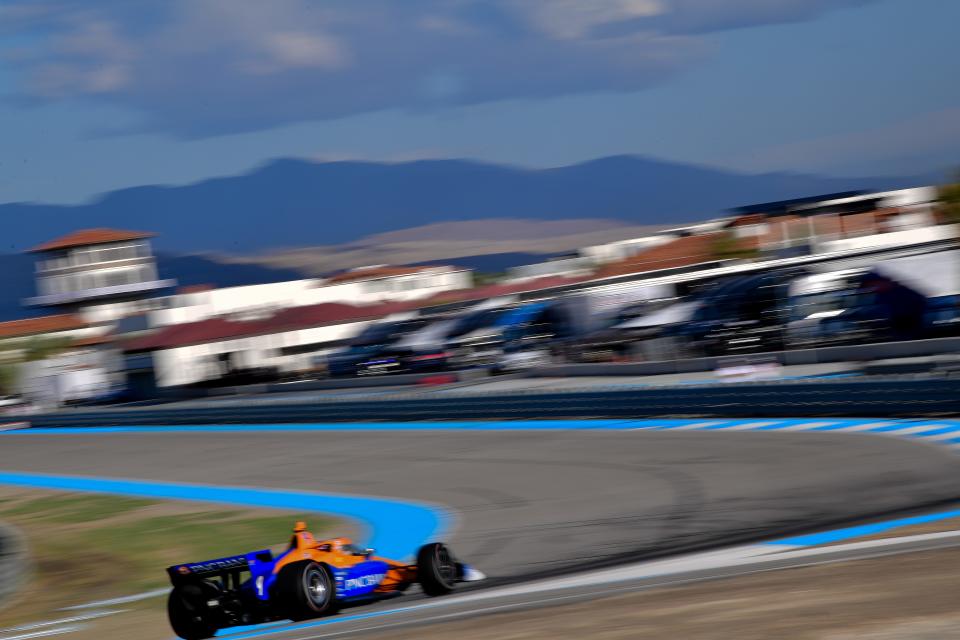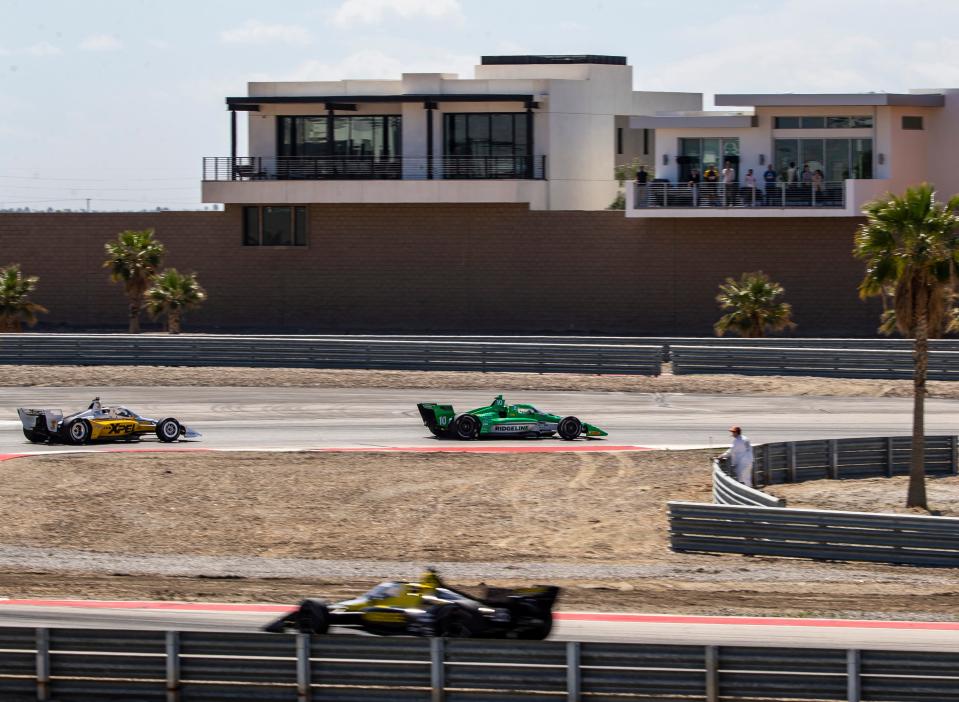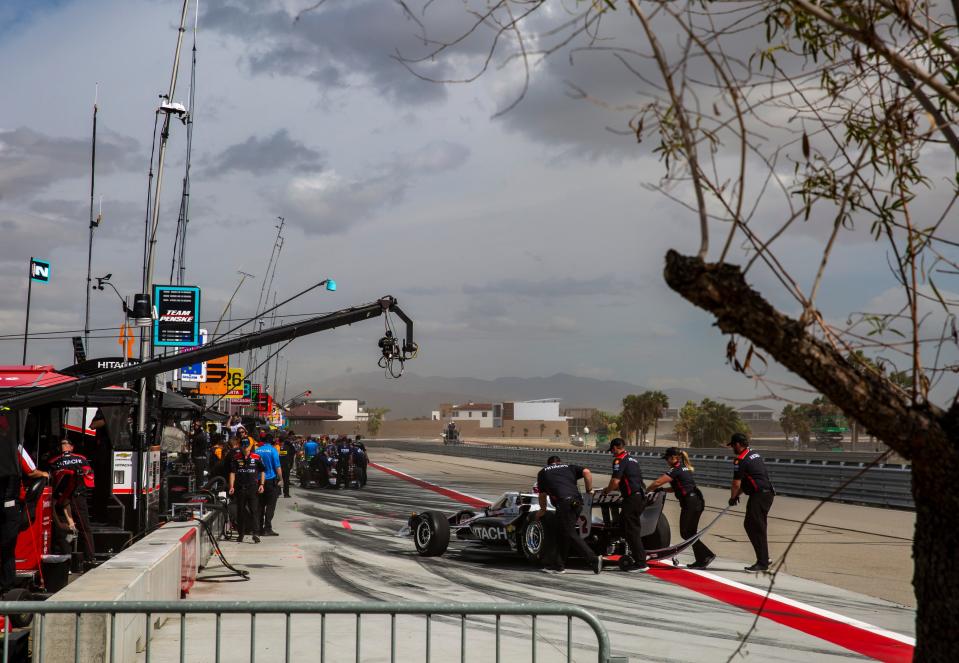Insider: IndyCar needs to take chances ... but not like the $1 Million Challenge
IndyCar’s $1 Million Challenge at The Thermal Club – from the fan experience to the on-track product to the packaging and the fallout – was everything I thought it would be.
For better, and certainly, for worse.
The series’ attempt at its first non-points race in 16 years was precisely that: an attempt. An experiment, and in ways, a Hail Mary to try and conjure up interest, excitement, energy and storylines in what would’ve otherwise been a painful dead period in a calendar that only just finished a six-month offseason riddled with bad headlines.
It’s something those in and around the sport have been begging for since Roger Penske, outfitted with billions in his bank account and nearly as much cache in the racing and auto industries, took the reins four years ago. But it was a reminder that Penske’s tenure atop IndyCar has yielded few truly positive wholesale changes.
The verdict is still out on the remakes of Iowa and Milwaukee, as well as the return to Detroit’s downtown streets. But when you get past those, you’re left with failed negotiations for a third manufacturer and continued hybrid delays that offset positive gains in fan metrics, Indy 500 excitement and general series stability.
The $1 Million Challenge served as an opportunity on a major stage – an NBC network TV window during a major sports weekend, run live in front of some of the country’s richest motorsports enthusiasts – for Penske Entertainment Corp. to capture an impactful victory. It came away with a proverbial participation trophy – fitting for an event that celebrated its top-3 finishers who won a collective $1.1 million for their teams with a podium you and I could’ve built in a single afternoon after a visit to the local hardware store.
IndyCar swung. It made some contact – a foul ball, we’ll call this one. We’ll know in a year whether to call it a strikeout or a homerun.

Where the $1 Million Challenge fell short
Given the generally positive reviews of its first visit a year ago, IndyCar was likely to schedule a return visit to the desert 40 minutes outside Palm Springs for a multi-day test early this year, whether it included an exhibition race for the weekend’s finale or not. With the Sebring outing a week before St. Pete not a true “open” test – the field was split in half and race once each over two days – The Thermal Club is one of few road course venues that can offer IndyCar a respectable venue and reliable February or March weather.
Just how beneficial that testing was – with just three road courses with this package left before the introduction of the hybrid – depends on who you ask. But after an offseason where six teams hardly touched a track, the weekend as a whole for the paddock was hardly a waste. (Unless you’re Juncos Hollinger Racing, Ed Carpenter Racing and Andretti Global, left with crash damage that only came because of an event that offered no points and few meaningful paydays. Lucky for Andretti, Colton Herta’s strategy play for $100,000 can offset some of that.)
Where the $1 Million Challenge fell short was in the way it was packaged and billed: As a big-money, made-for-TV, All-Star exhibition event worthy of a TV spot that typically goes to IndyCar’s biggest, best, most energy-packed events. What we saw Sunday did better to advertise The Thermal Club’s luxurious amenities – an on-site sushi chef, a putting green, sprawling mansions with patios tailor-made for parties – than IndyCar at its best.
The most high-energy on-track moment was sparked by Colton Herta's alleged jump-start and Scott Dixon's miscalculation. It was followed by a handful of brief one-on-one passing duels that lasted seconds and mattered little, a meaningless half of a main event and a runaway winner.
Saving IndyCar Thermal Club experiment: 9 ways to improve the $1 Million Challenge
Credit to teams – namely Andretti Global COO and Herta’s strategist Rob Edwards, as well as the driver – for quickly finding and exploiting a loophole in the rules. They featured a 20-lap finale with short break after 10, so that cars could reach that 20-lap mark without a pitstop to take that variable out of the event. By not allowing teams to take new tires in that break, it incentivized Herta and others starting in the back to treat the first half like an elongated warmup to preserve their tires for the Lap 11 restart with the pack bunched back up.
For what it’s worth, it worked – Herta started 12th and finished 4th, netting his bosses a gain of $77,000 in prize money. That veteran and brand-new fans alike were subjected to such a brilliant strategy play that was anything but “racing” in an ‘All-Star,’ ‘made-for-TV’ event was a failure in foresight.
Participation trophy for the attempt. A generous D for the execution.

Why the $1 Million Challenge had some successes
For those fans in attendance – whether they be run-of-the-mill, driver-jersey-wearing diehards, Club guests sporting a Peter Millar polo and Prada sneakers or members themselves – there was little not to like on the grounds. A $500 ticket bought you all-you-can-eat food truck meals for three days from local favorites and nearly 13 hours of on-track running. Fans could rub shoulders with drivers in the toffee ice cream line or snap selfies while waiting for a churro. And when they weren’t on-track, many held brief Q&A-style meet-and-greets out in the open.
If I’m a fan, I’m grinning from ear-to-ear on my flight back home. But we were told for months by series executives, after asking why IndyCar was holding this spectacle behind gates, walls and armed guards, that the $1 Million Challenge was never meant to cater to a ticket-buying crowd.
Ironically, it’s the group it served best, along with a host and promoter who landed hours of what amounted to advertisements for prospective members. If The Thermal Club lands even a couple new members who pay well over $5 million in initiation fees, monthly membership costs, land and a brand-new mansion, then its investment will have paid off. And if the greater IndyCar landscape has now piqued the interest of the next Jim Meyer (MSR co-owner) or a connection to the next Hy-Vee, then perhaps this dud will have been worth it.
But the $1 Million Challenge, in its simplest form, was held because a network TV window was open – because Texas Motor Speedway, one of the series’ oldest partners, decided an IndyCar date in 2024 in front of a few thousand fans wasn’t worth the scheduling headache. What followed was a placeholder – nothing more, nothing less. When you posed that aspect of the event to IndyCar executives, you were often met with some version of, “Doing something – anything – on NBC to break up the six-week gap is better than nothing at all.”
Two days later, after waiting to properly digest what I saw and heard and felt, I’m still not sure I’d agree, and I’ve got the event’s paltry TV ratings to prove it. According to the Sports Business Journal, IndyCar averaged just 816,000 viewers combined on NBC and Peacock -- its worst number for a network race without an NFL conflict since July 2022.
Reaction to $1 Million Challenge: Drivers praised IndyCar's ingenuity, but one called for 2025 boycott

IndyCar has to execute future experiments better
IndyCar, right now, is in ‘growth mode.’ While Penske Entertainment has delivered what I’d call solid fan growth metrics, discontent in the paddock has bubbled to the surface. Secret team meetings, private – and now public – scathing retributions of its ownership and brand-new committees in response to teams’ unrest paints a picture of a sport uncertain of where it’s headed.
New car in 2027? Mid-season engine formula change? Returns to dormant ovals that have failed in the past? A street race finale that proved DOA? A manufacturer considering an exit ramp?
It’s no secret that, after the stability Penske ushered in in the wake of the pandemic, what IndyCar needs to start its next chapter are attention-grabbing, fandom-inspiring, action-packed moments to sprinkle across its calendar and build its drivers’ star power. Those successes don’t come without risk or experimentation – and to its credit, IndyCar is pursuing those goals by other means, too.
But when you’re not equipped with even a fraction of the financial might as your two gargantuan competitors -- Formula 1 and NASCAR -- you have to pick your big swings all the more smartly. When someone questions the way in which you rolled the proverbial dice, your response can’t start with, ‘But what if…?’
Because if your Miami Grand Prix falls flat, you don’t have the dough to go build a race in Las Vegas from scratch. You can’t rent out the Coliseum or throw dirt on Bristol, wait a few years for those tests to fail to launch, and then move onto the next big thing. Those with an ounce of realism understand why you’ve taken fewer swings than F1 or NASCAR by comparison – and it’s because you’ve only got a few at bats.
So don’t swing out of your shoes at a knuckleball. Your strikes are starting to add up. And if you step up to the plate in a year and miss again, that clamoring you hear from the cheap seats, begging for you to be benched in favor of that flashy young upstart, is only going to build.
This article originally appeared on Indianapolis Star: Insider: IndyCar swung and missed with $1 Million Challenge experiment

